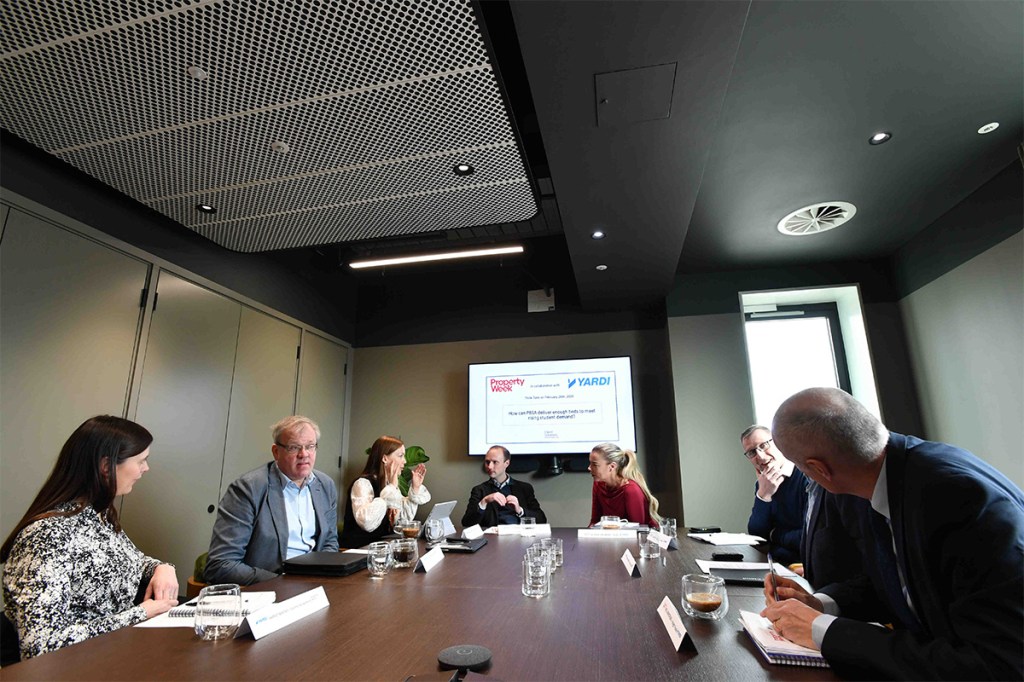Student numbers at UK universities are at historic highs, with more than 2.8 million enrolled in 2022. Some 20% of whom are international. And with more students comes greater demand for accommodation – demand that is not being met. A student housing shortfall of no fewer than 620,000 student beds is anticipated by 2026.

Expert panel
- Neil Armstrong, partner, joint head of student property, student property valuation & advisory, Knight Frank
- Harriet Bantock, associate, student accommodation, capital markets living, Cushman & Wakefield
- Georgie Drewery, senior account executive, Yardi
- Michela Hancock, managing director, Greystar Europe
- Paddy Jackman, chief executive, Unipol
- Sam Scott, managing director, Fresh Property Group
- Stephen Young, senior investment manager, Kajima Properties (Europe)
- Chair: Andrew Saunders, contributing editor, Property Week

So, what is behind the shortfall? How can the PBSA sector deliver more beds and help stave off the growing crisis in student housing?
What are the key factors behind the shortfall in student beds, and how is it impacting the student experience?
Paddy Jackman: There are now Manchester students who are living in Liverpool, for example, and some students are even living in a different country – there are around 250 from Bristol who live in Newport, south Wales.
It all starts with the way the universities are funded. They have a fixed income for their UK students. The only way that most of them can grow their top line and cover rising costs is by recruiting international students. So, we end up with unplanned student numbers. It is very difficult to drive a supply that meets that kind of demand.
Neil Armstrong: There is rising demand from domestic students as well as international. By 2030, there will be one million applicants a year to UK universities [according to admissions service UCAS], up from 760,000 currently. At the same time, outside PBSA, there are a lot of investors pulling out of the PRS [private rental sector] and HMOs [houses in multiple occupation] because of changes to legislation and taxation. All these factors are competing to cause the shortage.
Harriet Bantock: There is still a knock-on effect from COVID-19 if you look at the data. Between 2015 and 2020, we were seeing above 30,000 beds being delivered a year. But, from 2020, 50% of schemes had a two-and-a-half-year delay. It is only now that we are seeing supply increase again. This academic year, 2024-25, we will have 18,000 beds come through and next year will be a record year for delivery.
Georgie Drewery: Our clients tell us that rising construction costs and labour shortages are also really squeezing their margins. It’s slowing down the building process, too.
Is PBSA too expensive for students compared with traditional PRS digs?
PJ: A rough figure at the moment is that you cannot build [new PBSA] for rents of much less than £205 a week – that’s in the regions; it’s higher in London. That is unaffordable to the majority of UK students. There are still 500,000 students in HMOs, most of which are at a very different price point. Going right back to fundamentals, that means we have students choosing where to study based on what they can afford rather than what they would really like to do.
Sam Scott: I would challenge that a little. Even though I am someone who looks after PBSA developments, my son is at university now and he has opted to go into an HMO next year. I am obviously not selling PBSA very well! But when I look at the rents, and the fact that he and four other people are obligated to cover the total rent if one of them drops out, and the bills that you have to add on, we really are not that far away [from PBSA rents].
What can be done to boost supply?
NA: In my view, the joint venture [JV] between Unite and Newcastle University announced in February will probably become a model for the future. [Ownership of the new £250m, 2,000-bed development in the city will be split 51% to Unite and 49% to Newcastle University, with the university contributing its land on a 150-year lease.]
Stephen Young: In general, investors are always fighting a huge land price in the financial model. There is a mathematical temptation to pitch rent at the top decile. Because of the supply-demand imbalance you could do that, it can be viable.
“I visited one site and the most popular amenity was a TikTok room where students could record videos. I’d never have thought that would be the most popular thing but, of course, it is a source of income to some students who get paid for posting content.”
Georgie Drewery, Yardi
But you have these huge campuses owned by universities, and the ability to JV with them, where the universities could effectively put the land in for free and run a profit-split model over 20 or 30 years. That is income for the university and income for the investor. You’ve got in at a price that enables you to build something that is more affordable for the customer, too.

What is more important to students: amenities like gyms and shared space, or affordability?
GD: I think PBSA is still seen more as a luxury, and if I am paying a premium rent I do expect the amenities to be there. I visited one site where the amenities were amazing; they even had a climbing wall. But the most popular amenity they had was a TikTok room where students could record videos. I would never have thought that would be the most popular thing but, of course, it is a source of income to some students who get paid for posting content.
PJ: There is no student survey where having a gym is even in their top-five amenities.
I would love to think that the sector could work together to come up with something that was amenity-light and more affordable. But that would require a lot of work to say to students that they are better off taking amenity-light accommodation and being able to experience everything that university life has to offer, rather than working part time for 30 hours a week to afford a higher-class option.
HB: Universities may already have large, cheap gyms for students to use. So, having a few small ones [in a PBSA block] is probably not really necessary in those cases.
NA: We are finding that more and more people do recognise that PBSA provides something that is much better [than HMOs]. It started when fees came in in 2012-13 and then again during COVID. In our 2021 student accommodation survey with UCAS, PBSA providers came out very much on top compared with HMO landlords in terms of the student experience. [Of the students in PBSA who were surveyed, 69% felt positive about their accommodation provider’s COVID response, compared with just 25% in the wider PRS.]
Is the student housing shortage confined to the UK or is it more widespread?
SY: It is a macro issue; it is happening across Europe. In some ways the UK is fortunate, as provision is among the highest of any European market.
At Kajima, we are attracted to newer markets with very low provision rates, such as Poland where there are 95 students for one private bed. [Kajima is joint owner of Student Depot, Poland’s largest student accommodation provider.]

We want to put more beds into Poland and go into new markets like Italy, where we would love to have a presence. But there is a limited field of local partners that can add value across origination, development and management.
What are the current major operational challenges in PBSA?
SS: The main cost that factors into running student accommodation is people. We have all seen the headlines around inflation and wage growth and we have a high churn in this sector. So, when it comes to recruitment, we are just as challenged as everyone else. And then there are utility costs and maintenance – contractors’ prices have gone up too because they are affected by all the same issues that we are.
Can technology help alleviate these challenges?
GD: What we hear from our clients is that technology integration is a significant challenge when it comes to student portfolios, especially as there is very high turnover [as most students move each academic year].
“The main cost that factors into running student accommodation is people.”
Sam Scott, Fresh Property Group
It can be hard to scale when you have repairs, accounting and billing, for example, all in multiple different systems. Aligning the technology stack so you have one system that can do it all makes for much better operational efficiency and a smoother experience for students.
Michela Hancock: The technology has to make people’s lives easier, and be easy to understand. Sometimes, I think we look at tech because it is shiny and new, but does it actually work for the residents and the operations team? Is it so hard to explain that no one knows how to use it?
Is there a skills shortage as well as a beds shortage in the sector?

MH: At Greystar, we train our teams properly and consistently for what is an intense job. Our teams on site are effectively running our business model and reporting financials to investors, as well as looking after the wellbeing of students.
But unlike in the US [where there are degree courses in property management], in the UK there is not a funnel of team members coming through who have had four years of intensive study and can go straight in as a leasing associate.
PJ: We need to recognise that being able to handle the needs of predominantly 18- to 21-year-olds is a very particular skillset. At Unipol, we want to do something about that: find a partner university [to offer degrees in property management] so that people can see there is a career structure ahead of them and we can get some stability into the market in terms of recruitment and retention.
As we head towards a general election later this year, what should a new government be thinking about when it comes to student accommodation?
NA: The debate is not really about student accommodation. It is about funding for the whole sector, which is a bit broken.
MH: Planning should be more flexible and mixed tenure should be encouraged. I think there has been a shift in many [local planning] teams to focus more on residential than on student schemes. But it is not one size fits all – you need to plan for all the asset classes.
PJ: Last October, our ‘Ten Cities’ report found that a student with the average loan had just 50p a week left in their pocket after paying rent. So, I would love to see a more realistic conversation about funding and the kind of residential experiences we can afford to provide.